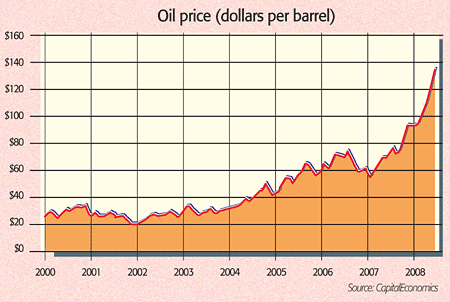
Last weekend’s widely-watched oil summit in Jeddah turned out to be little more than a talking shop, with scant impact on oil prices. Saudi Arabia, the only oil producer capable of expanding output rapidly, confirmed that it would boost production by 200,000 barrels per day (bpd) – a well-trailed figure that fell short of the 500,000 some observers had been hoping for. That takes overall production to 9.7 million bpd, the highest in almost 30 years, and leaves its spare capacity at 1.5 million bpd, the lowest in a generation.
Another problem, as The Economist points out, is that much of its new output is in the form of heavier oil that is more expensive to refine, and for which there is less demand. And recent losses from Nigerian production “wipe out” any fresh oil offered by the Saudis, says Robert Laughlin of MF Global. Nigerian production has slumped to a 25-year low of 1.5 million bpd, around one million barrels below its usual capacity. Sabre-rattling by Iran and Israel also helped send oil prices back towards last week’s record of $139 a barrel early this week.
China’s decision to reduce oil subsidies (petrol and diesel will go up by 18%, the biggest one-off increase in at least a decade, while electricity prices will rise by 5%) sent oil prices down by $5 last Thursday, but they soon recovered. Domestic fuel prices are still 70%-90% below international levels, while the short-term result may, paradoxically, be higher demand. China’s refiners have suffered from selling fuel at capped levels, but buying it on the open market. Now that their margins will rise, they look set to import more oil and boost sales to ease current petrol shortages.
Still, by pressing on with price liberalisation, China has signalled that consumers will have to bear more of the cost of fuel, says Capital Economics. “Ever-accelerating demand for commodities cannot be taken for granted.” The extent of the price jump “suggests some softening of oil demand growth is likely”, reckons Helen Henton of Standard Chartered.
Other Asian countries have also allowed fixed fuel costs to rise of late. As countries subsidising fuel account for all of current demand growth (China comprised 32% of global consumption growth last year), gradually allowing fuel to reflect market conditions is expected to lower demand and oil prices over the longer term, says Carola Hoyos in the FT.
Meanwhile, as Andrew Bary points out in Barron’s, it’s “impossible” to gauge the impact of speculative positions and commodity index funds, as most trading happens in over-the-counter transactions, away from the major commodity exchanges. “No doubt” there is “speculative froth” in the market, but it isn’t possible to prove if it is contributing $5 or $50 to the price, says Julian Jessop of Capital Economics.
However, it’s certain that there will be a “rush for the exits” when oil tops out, says Martin Spring in his OnTarget newsletter. Note that world demand growth is forecast to fall to 0.9% this year and it is likely to be “significantly less” next year as the credit crunch-induced slowdown deepens and possibly ends in recession.
A major issue in this context is that the developing world’s – especially Asia’s – efforts to crack down on inflation presage a slowdown, and possibly a sharp one, in the region. That in turn implies a drop in demand for commodities, which would send prices “tumbling”, says Bill Emmott in the Evening Standard.
So while there may be further spikes in the short term, Spring’s prediction that “late this year or early next, oil is likely to fall from current levels” looks reasonable. Nonetheless, given ongoing problems on the supply side, he says, “I’ll be surprised if crude goes below $90 a barrel”.
The big picture: soaring oil means dearer plastic bags
Some shops in Britain have begun charging for plastic bags, and the rest may soon follow – not to show off their green credentials, but to recoup the rising cost of plastic. Due to the soaring cost of oil products, chemicals groups supplying the plastic packaging industry are passing on hefty price increases.
Ethylene, a gaseous by-product of crude oil refining and the raw material for plastic bottles and bags, is on the rise, as is polyethylene, the most common plastic. Dow Chemicals has just announced the second round of price hikes in a month; Saudi Arabia’s SABIC will raise its polyethylene prices by €200 a ton from July.